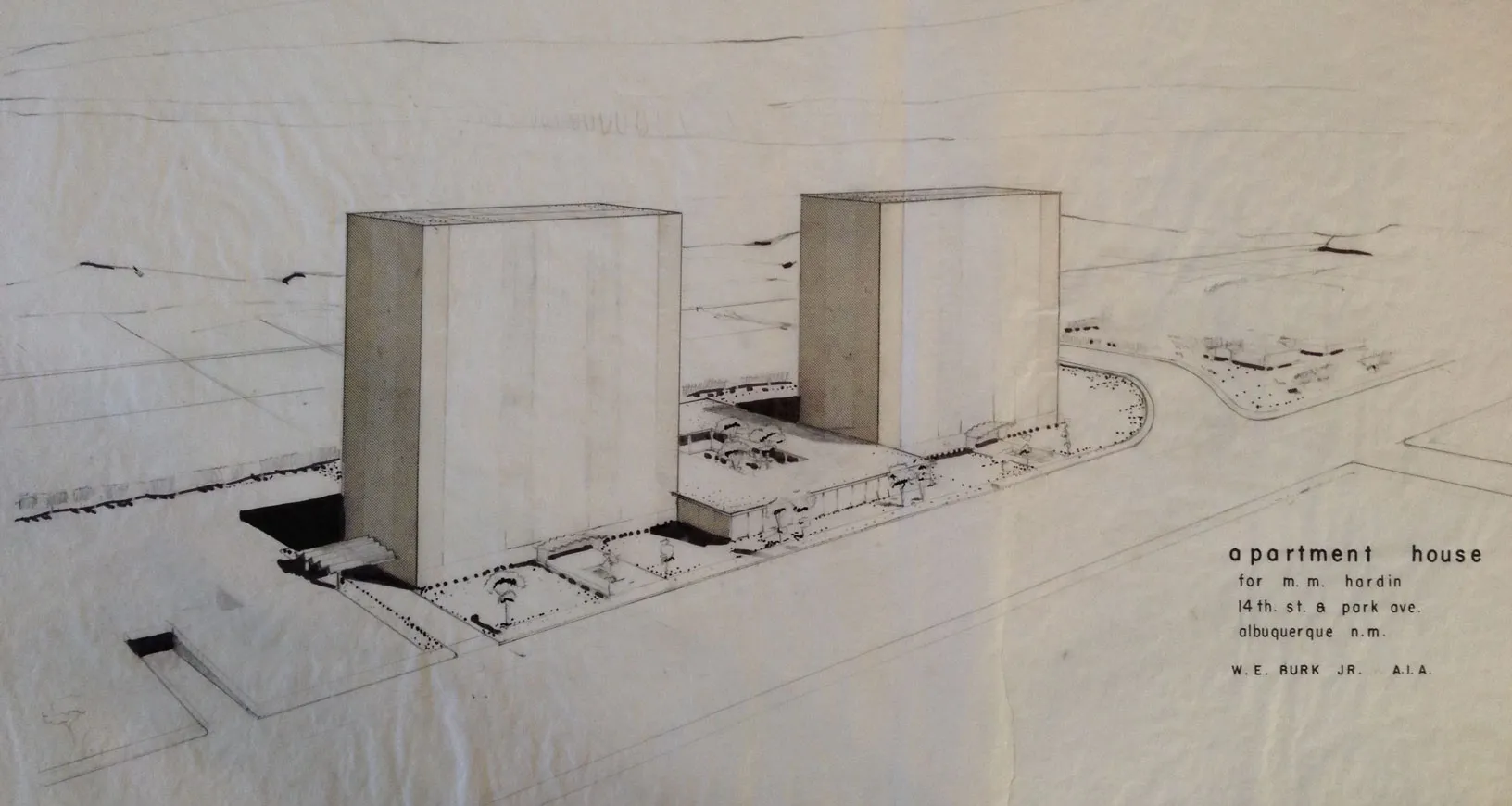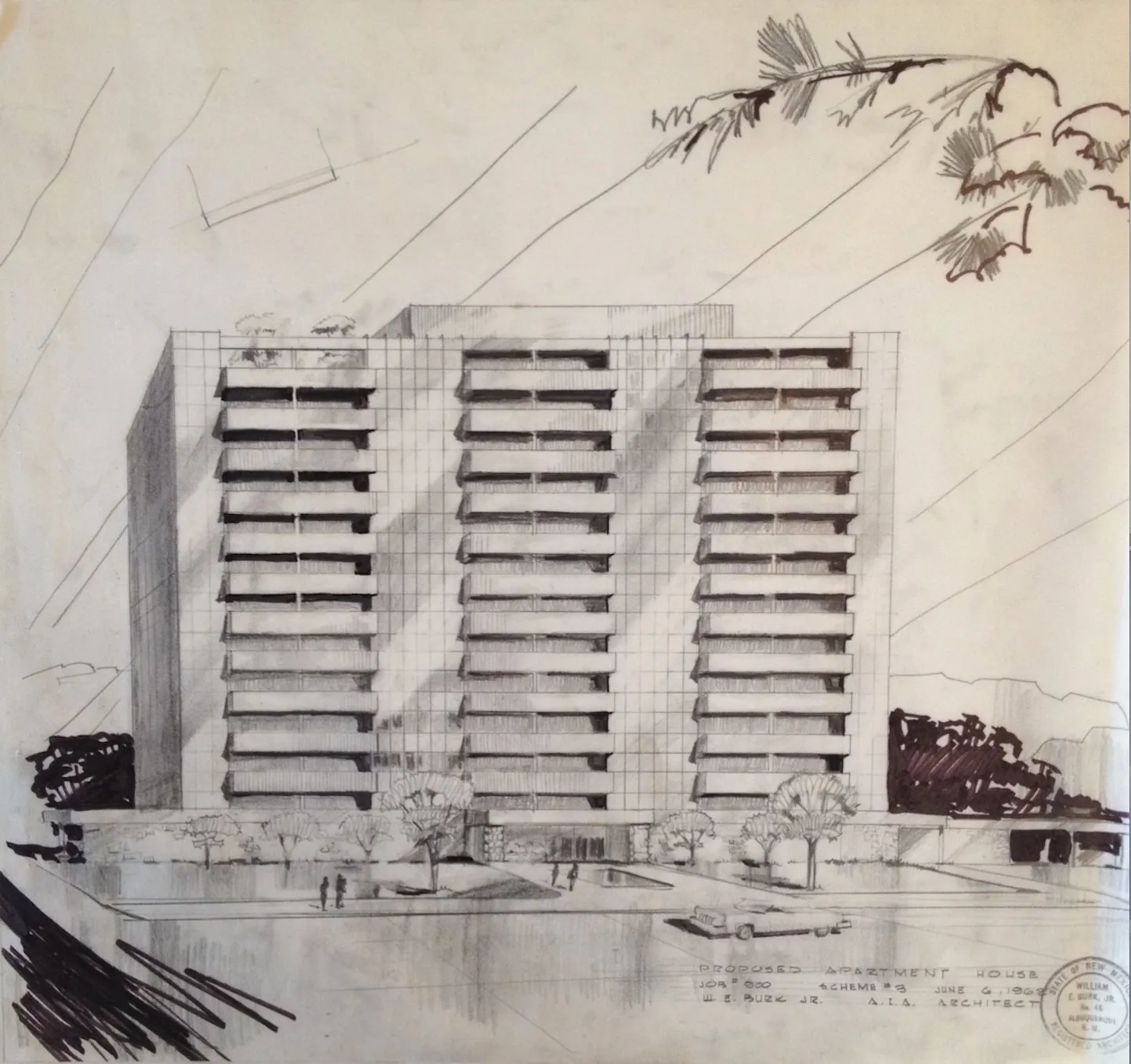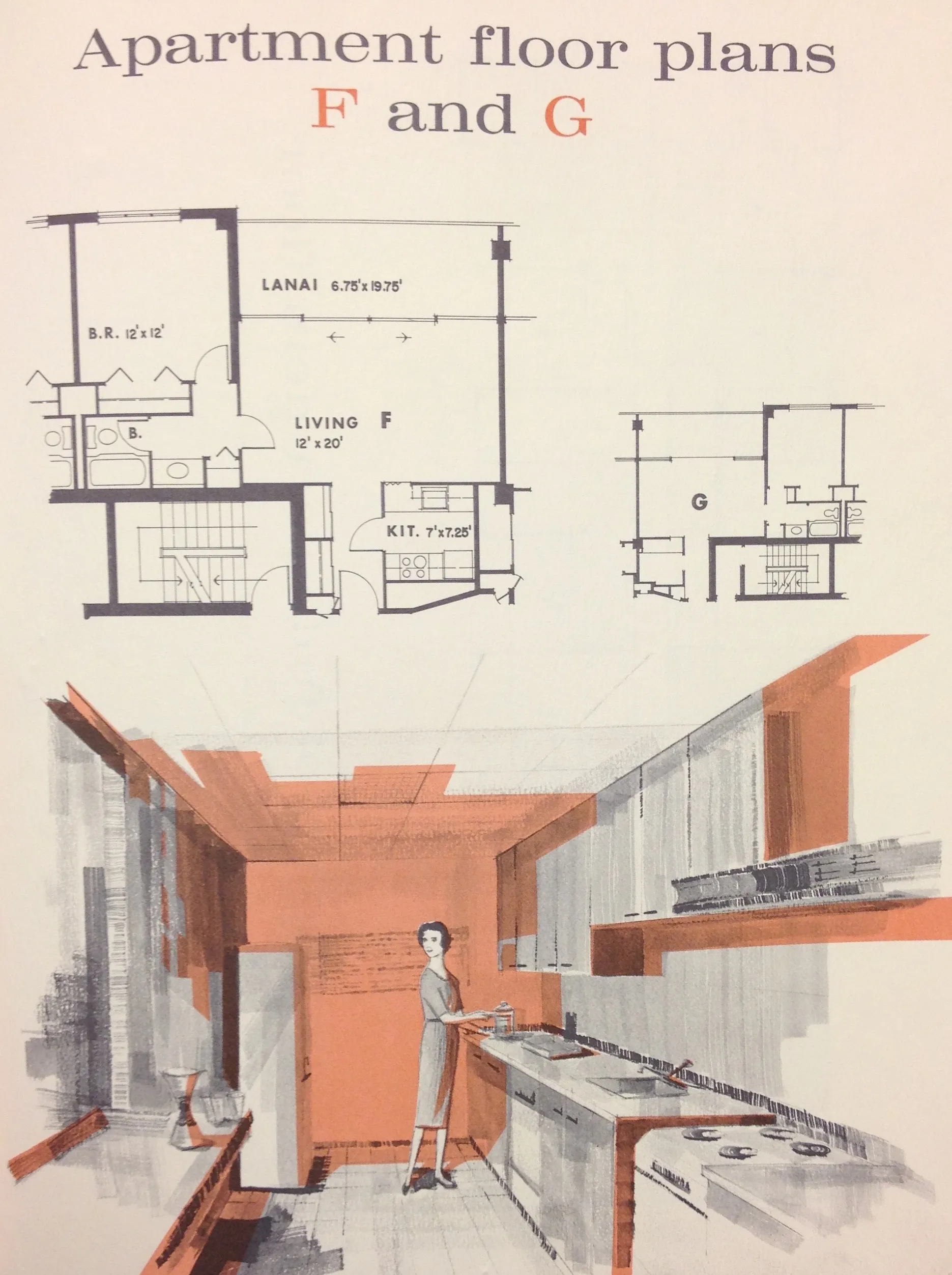1964
William Burk, Jr.
Case study by:
Stefan Johnson,Fri Oct 09 2015
Park Plaza Apartments

Park Plaza offers to discerning Albuquerqueans a new concept in gracious living. Gone are the household concerns. Comfort, privacy and convenience are enjoyed in an atmosphere of elegance provided by the southwest’s most beautiful and modern apartment building. PARK PLAZA is Albuquerque’s prestige address! —Park Plaza Sales Brochure, 1964.1
With an address of 1331 Park Avenue SW, but a location on 14th Street SW, just north of Park, the Park Plaza Condominiums tower 14 stories high, establishing a stark contrast with their primarily residential surroundings. On the border of the Raynolds Addition and Huning Castle neighborhoods, adjacent to modest single-family homes to the east and the grander homes to the west that surround the Albuquerque Country Club, and visible throughout much of Albuquerque, Park Plaza today represents an idiosyncratic approach to housing in its sprawling city, much as it has since it first opened its doors in the mid-1960s.
Completed in 1964, Park Plaza is the tallest high-rise “luxury apartment” building in New Mexico. Designed by architect William E. Burk, Jr., the building was unlike anything else in Albuquerque at the time. The project’s backers, M.M. Hardin of American Gypsum, Dan R. Ponder, from El Paso, Texas, and C.H Leavell & Co., a contracting firm also from El Paso, sought to give Albuquerque something different from the booming suburbs that marked its postwar expansion.2 In many ways, their striking tower succeeded; when construction finished, Park Plaza contained 151 units offering tenants mostly one- and two-bedroom units with larger units located on the upper floors, all with views of the growing city and many with prospects on the surrounding mountains. Park Plaza immediately enjoyed the reputation of being one of Albuquerque’s finest multi-family, luxury residences.3
In the years preceding the project’s genesis and after World War II, Albuquerque experienced a massive population boom. In 1940, the city’s population was 35,449. By 1950, it had ballooned to 96,815, and by 1960, the city had grown to a whopping 201,503 people.4 This growth, which concentrated on the city’s fringes, had a massive effect on its downtown core as many retailers, doctors, and residents moved out of the center to a more suburban context.5 Central Albuquerque was left out of the building boom for the most part, while the city’s East Mesa saw explosive growth fueled by large residential developers and close proximity to Kirtland Air Force Base and Sandia National Laboratories.6 This style of development marked the predominant response to Albuquerque’s housing shortage, a story that unfolded in many cities in the postwar era. Yet while suburban, single-family homes were by far the norm as Albuquerque grew, the housing shortage also drove efforts to build alternatives to this type. Though on a smaller scale, one such alternative took the form of new downtown residential construction, seen most notably in Park Plaza and the few other buildings like it (most similarly, the ten-story Alcalde Place apartments, located nearby). These buildings filled a niche for people who wanted upscale city living in a market dominated by the popularity of the suburban approach.
High-rises like Park Plaza represented an effort to attract middle-class families back to the core of the city at a time when that approach was decidedly not in the mainstream, and Burk adopted an architectural strategy that symbolized the building’s role as an outlier. With its considerable height in a relatively low city, Park Plaza could be spotted from miles away, towering over its surroundings. Designed in the language of mid-century modernism, the building carried a cutting edge and distinctive stylistic approach as well. Burk’s use of simple, powerful forms and modern steel construction referenced an architectural typology that was foreign to a city like Albuquerque. Typically, high-rise luxury apartments were built in places like Chicago, California and New York City.7 For its supporters, Park Plaza’s emergence was a sign that Albuquerque, too, had “arrived” as a city. As Hardin explained, “It shows Albuquerque is more of a city than it once was. It helps the skyline; it helps the downtown area by giving it more of a feeling that Albuquerque has arrived, that it is now the kind of a town that can maintain a high-rise.”8
This vision never really caught on at a city-wide scale. Today, the building still stands as it did in 1963, remaining largely alone as an example of this residential type among downtown blocks. Perhaps the construction of Park Plaza was an optimistic architectural gesture predicting faster core growth than was realistic for Albuquerque or perhaps it suggested an approach that did not really appeal on a large scale to residents of the booming Sunbelt. Among other reasons, this downtown-focused model was undermined by Albuquerque’s love affair with the car and the Cold War-era cultural climate, which promoted the suburban lifestyle and stigmatized city living. These factors made Park Plaza an exception with a unique story, but one that has nevertheless always been successful on its own terms. Park Plaza appealed – and continues to appeal – to the type of people who enjoy comfort, privacy and convenience in the city, rather than on the urban fringe. In a place like Albuquerque, this has secured its place as an incredibly unusual example of its architectural type.
Ironically, the very federal agency that fueled much suburban growth made Park Plaza viable too. The project was aided with Federal Housing Administration (FHA) guaranteed loans. Federal backing made it possible to build large residential projects that were previously unfeasible, because local banks would not finance projects of this magnitude entirely at their own risk. The State Investment Council (SIC) backed Park Plaza financially, investing money from the teachers’ retirement fund and holding the mortgage on the $2.96 million project. FHA insured 90 percent of that total, guaranteeing $2.575 million and making the project both a safe and profitable venture for its supporters. SIC’s investment yielded 5.25 percent. As the Albuquerque Journal reported at the time, this was “the highest yield ever obtained from property investments in New Mexico.”9
The Park Plaza apartments were truly a modernist expression referencing similar projects in other metropolitan areas of the United States. During the schematic phase, Burk, a local modernist who had advocated for this style since the 1930s, proposed a variety of different options that made use of a slab-like formal approach—everything from single tower to twin tower schemes. Consistent across the drawings is a clearly modernist methodology with an austere aesthetic. Likewise, all the schemes focused on creating a complete living experience with various options for retail and parking, taking the suburban idea of a self-contained development and making it urban. One of the more extravagant plans proposed a full-blown shopping node, which would have ensured day-to-day needs could be met without leaving the building. The schemes that were not built were much more extravagant than the final project, perhaps a result of available funding or the relatively experimental nature of this project in the city. Yet Burk carried many of his architectural and programmatic ideas forward into the chosen scheme, a single tower that features a glamorous material palette starting at the front entryway. He used marble and Arizona stone extensively on the first floor. On the upper floors he accented large glass windows and lanais with orange metal panels that dominate the facade. The mass of the building consisted of yellow and white brick. Bronze lettering, window mullions, and door hardware spoke to the glamour and prestige of the building and its intended tenants. With its Park Avenue address (despite its 14th Street location), Park Plaza rather blatantly made a connection to New York, providing a familiar living option to migrants from larger cities. Indeed, amidst its surroundings, it seemed possible that Park Plaza had been dropped in from New York City.
In June of 1964, the Park Plaza Apartments opened to the public. Upon completion, the majority of the apartments offered were one- and two-bedroom units with the bigger units located on the upper floors. An article on the “Woman’s Page” of the Albuquerque Journal boasted everything that these apartments offered to potential tenants. Interiors were originally finished in the style of the era: beige, light green, and gray with all rooms carpeted throughout. Kitchens were finished in “bronzetone,” with all-electric appliances including ranges, dishwashers, garbage disposals, refrigerator/freezers, and exhaust fans and hoods. These well-appointed kitchens, with their state-of-the-art appliances, maintained the project’s luxurious atmosphere. The floor plans offered entry halls, large linen closets located near the bathrooms, and walk-in closets. Two-bedroom units included double wardrobes. The building was equipped with “automatic elevators” and “forced air heating and refrigerated air conditioning.” Additionally, it contained garbage chutes, washers, and dryers on each floor. Consistent with early plans, Park Plaza offered a variety of commercial amenities on site, including a beauty salon, barbershop, and delicatessen, suggesting an alternative to the city’s booming suburbs that nonetheless embraced the conveniences of the postwar era.10
Park Plaza presented a welcoming, grand façade to potential residents. As the original brochure explained, “A sweeping entrance greets you. Tiers of lanais tower to a 14 story height above street level shops. Parking areas are in a garden setting. Automatic elevators lift you swiftly to your floor. In a moment you are ‘home’ in spacious, attractive rooms. Open the glass sliding doors to your private lanai for a breathtaking view of the Rio Grande Valley or across the city to the mountains.” Even today, the brochure helps the reader to imagine what it might be like to live in such a place. Using words like “sweeping,” “lanais,” “garden,” “automatic,” “swiftly,” “spacious,” “private,” and “breathtaking” seduces a potential tenant, playing up that this is indeed the most distinctive address in Albuquerque. The imagery complements the text, depicting upscale “tenants” going about their daily errands dressed in high fashion clothing. The message is clear: this place is for someone who values the finer things in life and wants everyone to understand that. This vision continues with the description of the rooms. Apartments are “thoughtfully planned” and designed for “freedom and mobility.” Concerns that come with apartment buildings are addressed as well. The brochure notes that all rooms are soundproofed and the foyer provides a buffer of privacy for the apartment. Wall-to-wall carpeting, all-electric appliances, and refrigerated air conditioning all likewise ensure a comfortable living environment for tenants.11
M.M. Hardin, the developer of Park Plaza, lived in the penthouse on the 14th floor. In his words, “The biggest asset of Park Plaza are its tenants.” Most of the original tenants consisted of business professionals, who on the whole did not have children or were empty nesters seeking to downsize. A reasonable percentage were migrants to Albuquerque from larger cities. These tenants sought – and found – a community. Three years after the project was completed, it had hit some financial bumps, in part because it took a few years to fill up. Nevertheless, Hardin proved extremely positive in describing it to the Albuquerque Journal. “What success we have enjoyed thus far, we owe to the tenants,” he told a reporter. “This is more like a big fraternity than an apartment house. The tenants like the location. They like the environment. There is a great union among the people, a great sense of belonging. When one of the tenants is sick, the others bring in his meals and flowers….As a tenant, I enjoy living here too. The spirit of the people around here is one reason I want to stay with it.” Paraphrasing Hardin, the article continued, “The tenants are enthusiastic about showing their apartments to prospective tenants, and some have convinced their friends to sell or vacate their homes and move into Park Plaza.”12
The original floor plans that Hardin offered, denoted by letters A to G, varied in price from $170 to $270 in 1964. Despite these initial plans, however, the building and its backers proved quite flexible. Since the partition walls in the rooms were not load bearing, tenants could move them or even buy multiple apartments and combine them if they needed more space to fit their needs. Others enclosed the lanais, altering Burk’s façade but enlarging their interior space. Hardin encouraged the tenants to individualize their homes.13 These modifications can be seen in a 1979 brochure that followed a change in the building’s ownership. When Hardin left the building as a tenant he also sold it to Park Plaza Association Incorporated, a homeowners association that still owns it to this day, at which point the building turned into condos.14 These condos came in a large variety of sizes and price points due to earlier tenant improvements and modifications. The seven original floor plans had expanded to all manner of combinations, each with its own name. These evoked a sense of class and prestige that was consistent with the overarching theme of the building. Floor plans A-J were known as the Summit, the Tipton, the Empire, the Manhattan, the Lexington, the Madison, and the Cathedral. The other floor plans were combinations of these, with the largest being the Astoria, which measured 2,941 square feet and contained five bedrooms and five bathrooms. These names brought to mind thoughts of elegance and power, as well as an East Coast flair, with direct allusions to places like New York City. They thus spoke to the style of city living associated with those faraway locations and, by association, with Park Plaza. Perhaps they suggested just whom the homeowners association hoped to attract as neighbors—newcomers from elsewhere.15
Like the suburbs it competed with, Park Plaza proved able to adjust to its tenants over time. Indeed, at over a half-century in age, Park Plaza to this day encompasses an eclectic mix of renovated and original units that have allowed it to withstand a continually changing city. As a recent Journal article explained, “Coming full circle, Park Plaza once again is on the edge of a revitalized Downtown, and lies smack in the middle of an urban neighborhood where home sales are healthy as younger families and professionals migrate closer to the city core.”16 It can even be argued that Park Plaza was built fifty-one years ahead of its time. Today in 2015, there are signs of renewed interest in the building. According to the current building manager, two categories of tenants fill Park Plaza. The majority are older – many of whom are longtime residents – and make up about 70% of its population. But the other 30% have moved there because of a revived interest in the urban core and the lifestyle associated with living in the center of the city.17 Today Park Plaza is filling a slightly different niche, then, one that is more diverse and less concerned with distinguishing itself as Albuquerque’s “prestige address.” Rather, its appeal lies in the intriguing, unique nature of the building and its increasingly desirable location, within a city that otherwise mostly sprawls with single-family homes.
Footnotes
-
Park Plaza 1331 Park Avenue, S.W. Albuquerque’s Prestige Address (Albuquerque: Berger Briggs & Co., 1964), Collection of Park Plaza Condominiums, Albuquerque, NM. ↩
-
“Ground Broken For Apartments Near Downtown,” Albuquerque Journal, 15 May 1963, sec. A, p. 2. ↩
-
William A. Dodge, “National Register of Historic Places Multiple Property Documentation Form: Historic and Architectural Resources of Central Albuquerque, 1880-1970,” 31 July 2012, 31, accessed 12 December 2015. http://www.nmhistoricpreservation.org/assets/files/register-nominations/Historic%20and%20Architectural%20REsources%20of%20Central%20Albuquerque%201880-1970%20MPDF.pdf ↩
-
Ibid., 25. ↩
-
Ibid., 29. ↩
-
Ibid., 30. ↩
-
“Big FHA Mortgages OK’d by SIC,” Albuquerque Journal, 12 March 1963, sec. A, p. 1. ↩
-
W. Wilson Cliff, “Hardin Feels Park Plaza’s Future Bright,” Albuquerque Journal, 27 April 1967, sec. E, p. 10. ↩
-
“Big FHA Mortgages OK’d by SIC”; “Ground Broken For Apartments Near Downtown,” Albuquerque Journal, 15 May 1963, sec. A, p. 2. ↩
-
Taylor, “New High Rise Apartments To Be Viewed This Weekend,” Albuquerque Tribune, 26 June 1964, Sec. A, p. 8. ↩
-
Park Plaza 1331 Park Avenue, S.W. Albuquerque’s Prestige Address. ↩
-
“Hardin Feels Park Plaza’s Future Bright.” ↩
-
Ibid. ↩
-
Park Plaza Association Inc., Resident Handbook, accessed 12 December 2015, http://parkplazacondo.vertilinc.com/Portals/77/park%20plaza%20resident%20handbook%208-19-15.pdf. ↩
-
Park Plaza (Park Plaza Association Inc., 1978), Collection of Park Plaza Condominiums, Albuquerque, NM. ↩
-
Jane Mahoney, “High-rise,” Albuquerque Journal, 21 June 2009. ↩
-
Kevin Mahon, interview by author, Albuquerque, NM, 24 November 2015. ↩



